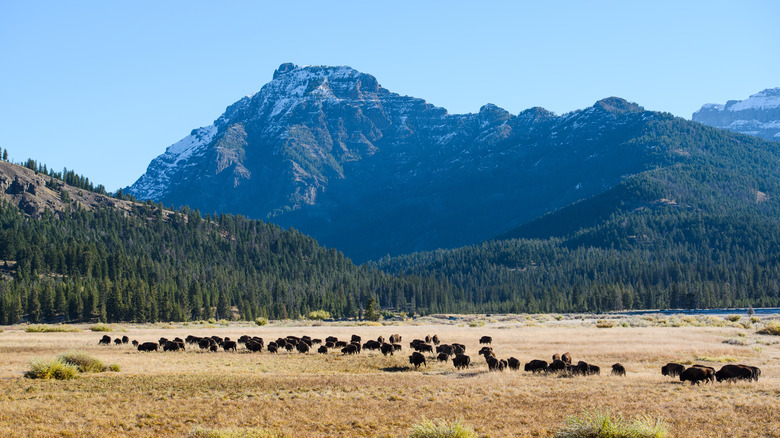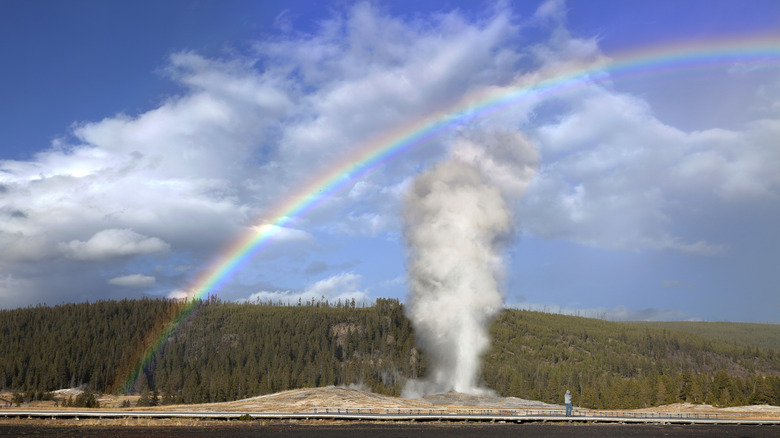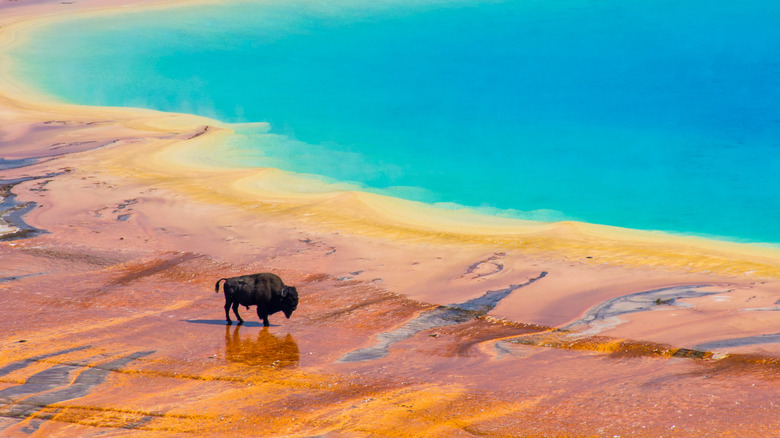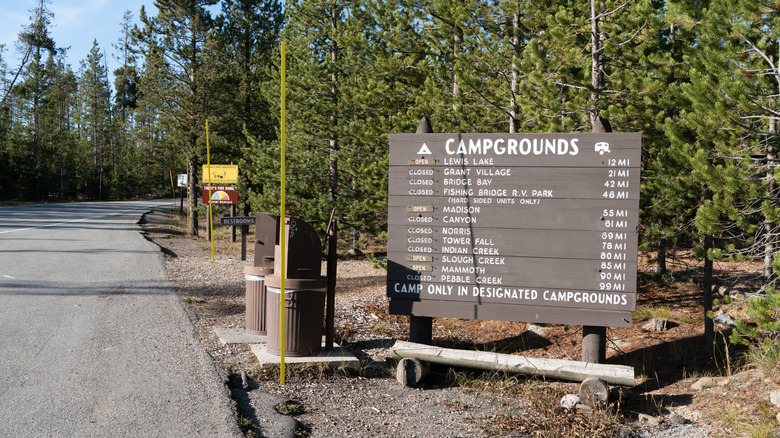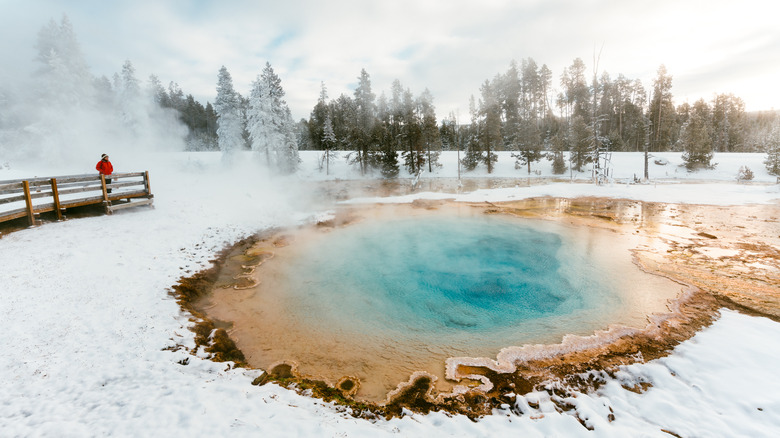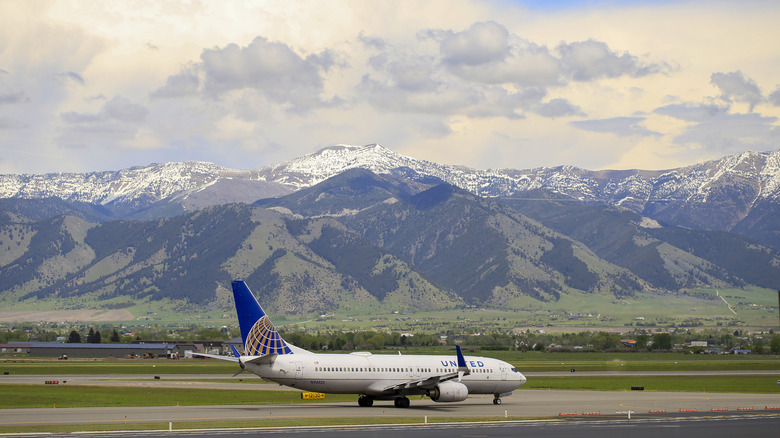It's No Wonder Yellowstone National Park Is On Everyone's Camping Bucket List
Being the first to do something always mean being the best, but in the case of Yellowstone National Park, it just might be. In 1872, Yellowstone National Park became the world's very first national park. This was thanks to President Ulysses S. Grant, who signed the Yellowstone National Park Protection Act into law.
The borders of this park are primarily in Wyoming but extend into Montana and Idaho. Covering more than 3,500 miles, it's one of the largest national parks in the U.S. However, size isn't everything, and, as you can imagine, it's what's inside the park that makes it truly amazing, from Old Faithful to the Grand Canyon of the Yellowstone to Mammoth Hot Springs. The incredible array of wildlife, the nearly endless number of hiking trails, and the range of campground options make Yellowstone National Park one of the top parks you have to see before you kick the bucket.
Yellowstone's unbelievable nature
What truly sets Yellowstone apart is the fact that it sits on top of a giant volcano. Thanks to this geological feature, the park is home to almost 50% of the geysers and hot springs that exist on the planet. This creates an ethereal effect, with areas of the park spewing hot steam and collecting pools of emerald-green water. One of the most famous geysers in the park — and likely the world over — is Old Faithful. This geyser can shoot hot jets of water almost 180 feet in the air and, as its name suggests, consistently goes off every 74 minutes on average.
Yellowstone is also a great place to do some stargazing since it has very little light pollution. If you want to see the Milky Way, head there anytime between April to November. Go to the Mammoth Hot Springs at night to feel transported to another planet as you gaze up at the stars.
Of course, you can't miss out on the many hiking trails in the park. With over 900 miles of trails to choose from with varying levels of difficulty, there's a trail to suit every visitor's needs and desires. One of the best is the Upper Geyser Basin and Old Faithful Observation Point loop.
The wildlife here will leave you speechless
Thanks to the conservation efforts of the National Park Service (NPS), Yellowstone is home to many different living creatures. According to the U.S. Department of the Interior, "Yellowstone's wildlife is abundant and diverse with an estimated 300 species of birds, 16 types of fish and 67 species of mammals — the largest number of mammal species in the contiguous United States." Of the mammals, the most exciting ones you might get a chance to see are grizzly bears, wolves, moose, elk, and lynx.
Of course, we can't forget the great bison herds that have roamed the parklands since prehistoric times. Yellowstone is home to America's largest herd of bison on public land, leading to frequent "bison jams." No, this isn't a new weird flavor of jelly for your morning toast, but the result of herds of bison crossing or walking down roads in the park causing traffic jams.
While bison and grizzly bears can appear to be humongous living versions of our favorite stuffed animals, it's imperative never to approach them. No matter how docile they might seem, they are still wild animals. There are regularly stories of park visitors attempting to approach a furry Yellowstone resident, only to find themselves on the wrong end of their horns or teeth. For this reason, the NPS advises visitors to stay 25 yards away from bison and elk and 100 yards from bears and wolves.
Yellowstone's camping and lodging options
Yellowstone has 12 campgrounds across the park with over 2,000 campsites to choose from. Like many popular U.S. national parks, you will need to reserve your campsite way in advance. For summer camping, you'll want to book your spot more than six months up to a year ahead of time.
Some of the best campgrounds to stay at are going to be Mammoth Campground, Madison Campground, and Grant Village Campground. Mammoth Campground is great for those who tent camp year-round, as it's the only Yellowstone campground open in all seasons. If you want to be in the heart of the action, Madison Campground is centrally located within the park. Grant Village Campground is the largest campground in the park and has a handful of stores and amenities nearby.
For those camping with RVs, you might be interested in the Fishing Bridge RV Park. With an abundance of grizzly bears near the Yellowstone River nearby, this is an RV-only campground, and no tent camping is allowed. This campground has full hookups available for RVs, and convenient amenities like laundry facilities are available.
If you're looking for something a little cozier to come home to after a long day of being outdoors, Yellowstone also has cabins and hotels. These include the famous Old Faithful Inn, which offers views of the famous geyser and is one of the biggest structures of its kind in the world.
Yellowstone has something to offer visitors all year long
The most popular seasons to visit Yellowstone are going to be spring and summer, with June, July, and August being the busiest months. Obviously, the weather is much more favorable during these months than in late autumn or winter; all the plants are in their full green regalia and the animals are more active.
However, there are many reasons to also consider a visit to Yellowstone during its low seasons. Autumn is a great undiscovered season as the park turns bright yellow and orange. This is also the best season to see elk as they enter their breeding season and can be heard bugling in the distance.
For some, wintertime is actually the best time of year to visit Yellowstone National Park, with snow covering every inch of the park except for the geyser basins. The park does limit its available services, and roads are closed to outside vehicles. However, you can book a snowmobile or snowcoach tour to get you to the Old Faithful Snow Lodge or the Mammoth Hot Springs Hotel.
With so many tourists having departed for these seasons, you can bet on great discounts for tours and accommodations. However, if you're neither a fan of cold weather nor the heaving crowds that flock to the park in the summer, consider visiting in May or September when the weather is only just beginning to turn and the numbers of tourists have faded.
It's easier than ever to get to Yellowstone and explore the park
Thanks to flight routes opening around the country, Americans and visitors to the U.S. can more easily visit more incredible national parks. Bozeman Yellowstone International Airport aka the "Gateway to Yellowstone" is about a 1.5-hour drive from the park but is one of the easiest ways to get to this part of the world if you live further away.
There are nonstop flights to Bozeman from popular hubs in the U.S. like Atlanta, New York, Denver, and Los Angeles. If you really want to make things easy on yourself, there are tours that will pick you up from the airport and take you directly to the park.
Finally, if you don't mind making a stop in Salt Lake City (SLC), you can also fly into Yellowstone Airport, which is only 2 miles from the entrance to the park. Currently, Delta Air Lines can fly you here from SLC for under $200.
However, once you've arrived, getting around the park is incredibly easy. The park infrastructure is driver-friendly and you can get to nearly every main attraction by car. Because of this, it's highly recommended that you consider renting a car or even renting an RV to get the most out of your trip.
